The Intel Xeon W-3175X Review: 28 Unlocked Cores, $2999
by Ian Cutress on January 30, 2019 9:00 AM ESTCPU Performance: Web and Legacy Tests
While more the focus of low-end and small form factor systems, web-based benchmarks are notoriously difficult to standardize. Modern web browsers are frequently updated, with no recourse to disable those updates, and as such there is difficulty in keeping a common platform. The fast paced nature of browser development means that version numbers (and performance) can change from week to week. Despite this, web tests are often a good measure of user experience: a lot of what most office work is today revolves around web applications, particularly email and office apps, but also interfaces and development environments. Our web tests include some of the industry standard tests, as well as a few popular but older tests.
We have also included our legacy benchmarks in this section, representing a stack of older code for popular benchmarks.
All of our benchmark results can also be found in our benchmark engine, Bench.
For our graphs, some of them have two values: a regular value in orange, and one in red called 'Intel Spec'. ASUS offers the option to 'open up' the power and current limits of the chip, so the CPU is still running at the same frequency but is not throttled. Despite Intel saying that they recommend 'Intel Spec', the system they sent to us to test was actually set up with the power limits opened up, and the results they provided for us to compare to internally also correlated with that setting. As a result, we're providing both sets results for our CPU tests.
WebXPRT 3: Modern Real-World Web Tasks, including AI
The company behind the XPRT test suites, Principled Technologies, has recently released the latest web-test, and rather than attach a year to the name have just called it ‘3’. This latest test (as we started the suite) has built upon and developed the ethos of previous tests: user interaction, office compute, graph generation, list sorting, HTML5, image manipulation, and even goes as far as some AI testing.
For our benchmark, we run the standard test which goes through the benchmark list seven times and provides a final result. We run this standard test four times, and take an average.
Users can access the WebXPRT test at http://principledtechnologies.com/benchmarkxprt/webxprt/
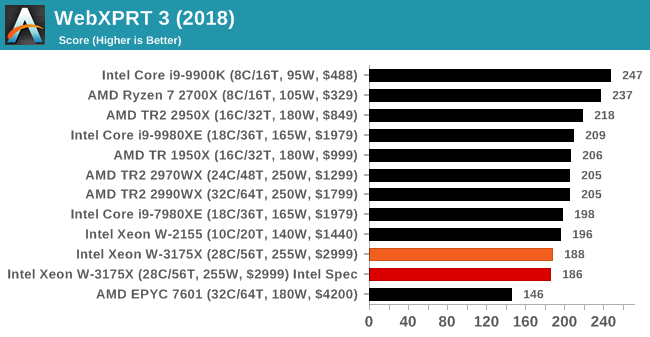
WebXPRT 2015: HTML5 and Javascript Web UX Testing
The older version of WebXPRT is the 2015 edition, which focuses on a slightly different set of web technologies and frameworks that are in use today. This is still a relevant test, especially for users interacting with not-the-latest web applications in the market, of which there are a lot. Web framework development is often very quick but with high turnover, meaning that frameworks are quickly developed, built-upon, used, and then developers move on to the next, and adjusting an application to a new framework is a difficult arduous task, especially with rapid development cycles. This leaves a lot of applications as ‘fixed-in-time’, and relevant to user experience for many years.
Similar to WebXPRT3, the main benchmark is a sectional run repeated seven times, with a final score. We repeat the whole thing four times, and average those final scores.
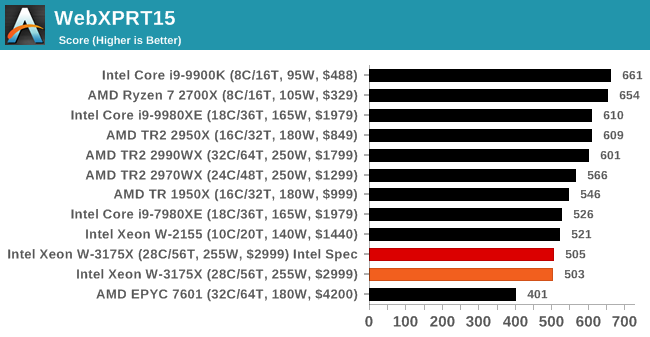
Speedometer 2: JavaScript Frameworks
Our newest web test is Speedometer 2, which is a accrued test over a series of javascript frameworks to do three simple things: built a list, enable each item in the list, and remove the list. All the frameworks implement the same visual cues, but obviously apply them from different coding angles.
Our test goes through the list of frameworks, and produces a final score indicative of ‘rpm’, one of the benchmarks internal metrics. We report this final score.

Google Octane 2.0: Core Web Compute
A popular web test for several years, but now no longer being updated, is Octane, developed by Google. Version 2.0 of the test performs the best part of two-dozen compute related tasks, such as regular expressions, cryptography, ray tracing, emulation, and Navier-Stokes physics calculations.
The test gives each sub-test a score and produces a geometric mean of the set as a final result. We run the full benchmark four times, and average the final results.
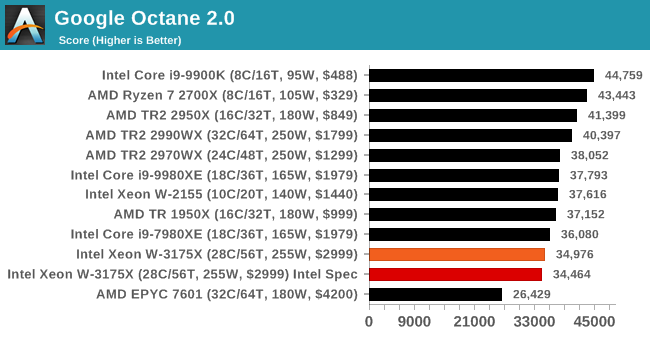
Mozilla Kraken 1.1: Core Web Compute
Even older than Octane is Kraken, this time developed by Mozilla. This is an older test that does similar computational mechanics, such as audio processing or image filtering. Kraken seems to produce a highly variable result depending on the browser version, as it is a test that is keenly optimized for.
The main benchmark runs through each of the sub-tests ten times and produces an average time to completion for each loop, given in milliseconds. We run the full benchmark four times and take an average of the time taken.
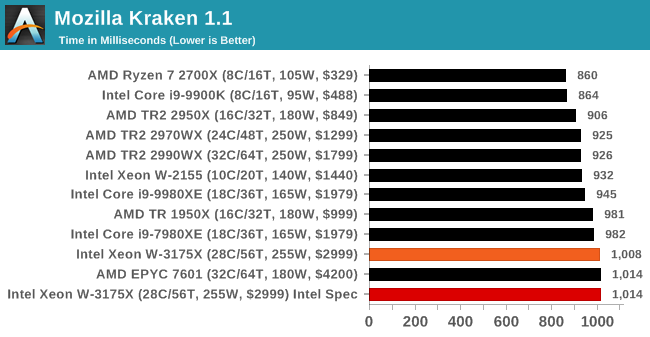
3DPM v1: Naïve Code Variant of 3DPM v2.1
The first legacy test in the suite is the first version of our 3DPM benchmark. This is the ultimate naïve version of the code, as if it was written by scientist with no knowledge of how computer hardware, compilers, or optimization works (which in fact, it was at the start). This represents a large body of scientific simulation out in the wild, where getting the answer is more important than it being fast (getting a result in 4 days is acceptable if it’s correct, rather than sending someone away for a year to learn to code and getting the result in 5 minutes).
In this version, the only real optimization was in the compiler flags (-O2, -fp:fast), compiling it in release mode, and enabling OpenMP in the main compute loops. The loops were not configured for function size, and one of the key slowdowns is false sharing in the cache. It also has long dependency chains based on the random number generation, which leads to relatively poor performance on specific compute microarchitectures.
3DPM v1 can be downloaded with our 3DPM v2 code here: 3DPMv2.1.rar (13.0 MB)

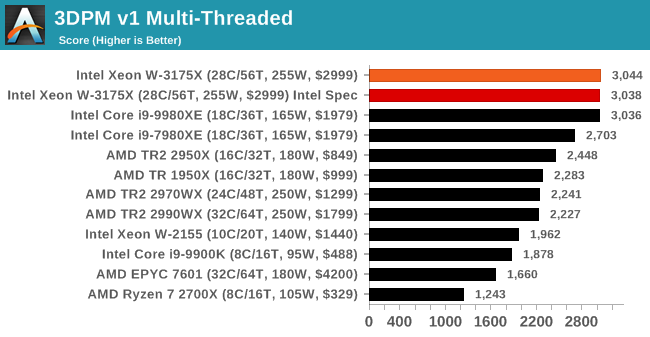
x264 HD 3.0: Older Transcode Test
This transcoding test is super old, and was used by Anand back in the day of Pentium 4 and Athlon II processors. Here a standardized 720p video is transcoded with a two-pass conversion, with the benchmark showing the frames-per-second of each pass. This benchmark is single-threaded, and between some micro-architectures we seem to actually hit an instructions-per-clock wall.

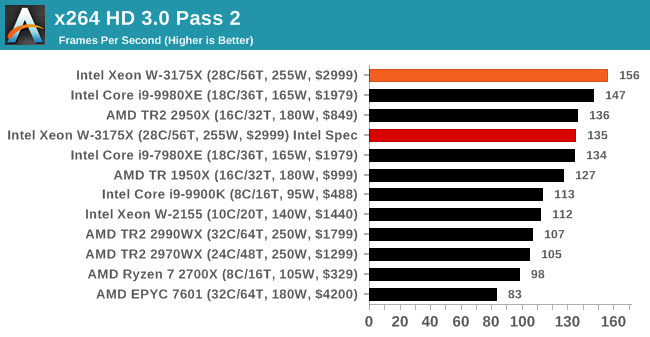










136 Comments
View All Comments
Yorgos - Wednesday, January 30, 2019 - link
it's not only program dependent, it's also scheduler dependent.It is found that the windows scheduler doesn't treat TR very well and throttles it down.(ref. L1T)
MattZN - Wednesday, January 30, 2019 - link
Yup, in a nutshell. When Microsoft finally fixes that scheduler issue all of these sites will have to rerun their benchmarks. While it won't run away on performance, the results will start to look more like they should given the HW capabilities. Not a problem for me with Linux but its kinda amusing that Windows users are so beholden to bugs like these and even the professional reviewers get lost when there isn't a convenient UI button that explains what is going on.-Matt
mapesdhs - Saturday, February 2, 2019 - link
Is that the same issue as the one referring to running on core zero? I watched a video about it recently but I can't recall if it was L1T or elsewhere.jospoortvliet - Sunday, February 3, 2019 - link
it is that issue yes. blocking use of core is a work-around that kind'a works.jospoortvliet - Sunday, February 3, 2019 - link
(in some workloads, not all)Coolmike980 - Monday, February 4, 2019 - link
So here's my thing: Why can't we have good benchmarks? Nothing here on Linux, and nothing in a VM. I'd be willing to be good money I could take a 2990, run Linux, run 5 VM's of 6 cores each, run these benchmarks (the non-gpu dependent ones), and collectively beat the pants off of this CPU under any condition you want to run it. Also, this Civ 6 thing - the only benchmark that would be of any value would be the CPU one, and they've been claiming to want to make this work for 2 years now. Either get it working, or drop it altogether. Rant over. Thanks.FlanK3r - Wednesday, January 30, 2019 - link
where is CinebenchR15 results? In testing methology is it, but in results I can not find it :)MattsMechanicalSSI - Wednesday, January 30, 2019 - link
der8auer did a delid video, and a number of CB runs. https://www.youtube.com/watch?v=aD9B-uu8At8 Also, Steve at GN has had a good look at it. https://www.youtube.com/watch?v=N29jTOjBZrwMattZN - Wednesday, January 30, 2019 - link
@MattsMechanicalSSI Yup... both are very telling.I give the 3175X a pass on DDR connectivity (from the DerBauer video) since he's constantly having to socket and unsocket the chip, but I agree with him that there should be a carrier for a chip that large. Depending on the user to guess the proper pressure is a bad idea.
But, particularly the GN review around 16:00 or so where we see the 3175X pulling 672W at the wall (OC) for a tiny improvement in time over the 2990WX. Both AMD and Intel goose these CPUs, even at stock, but the Intel numbers are horrendous. They aren't even trying to keep wattages under control.
The game tests are more likely an issue with the windows scheduler (ala Wendel's work). And the fact that nobody in their right mind runs games on these CPUs.
The Xeon is certainly a faster CPU, but the price and the wattage cost kinda make it a non-starter. There's really no point to it, not even for professional work. Steve (GN) kinda thinks that there might be a use-case with Premier but... I don't really. At least not for the ~5 months or so before we get the next node on AMD (and ~11 months for Intel).
-Matt
mapesdhs - Saturday, February 2, 2019 - link
Cinebench is badly broken at this level of cores, it's not scaling properly anymore. See:https://www.servethehome.com/cinebench-r15-is-now-...